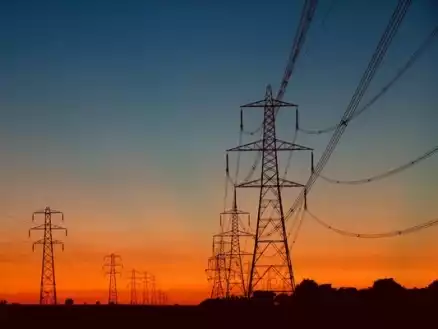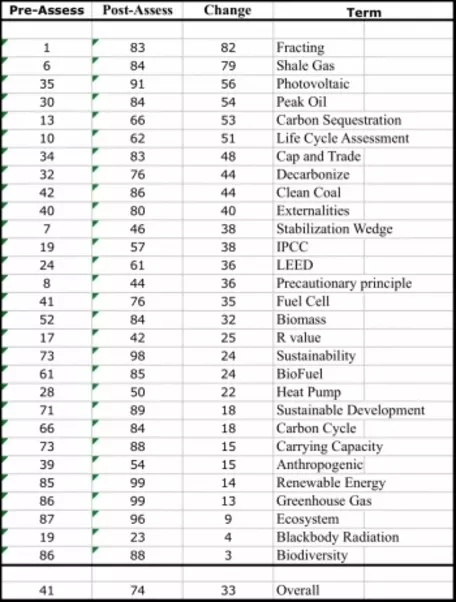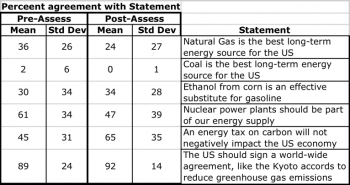Syllabus: Making Choices about Energy Technologies: A Major Challenge for Climate Mitigation
Summary
Learning Goals
Objectives:
Students who complete this course will be able to:
(a) Describe the principles of sustainability and compare the sustainability of different energy sources.
(b) Understand the scientific definition of energy and how it can be described in readily understandable terms
(c) Evaluate and compare the "true" cost of different energy sources, such as oil, gas, coal, nuclear, ethanol, and biodiesel
(d) Understand the connection between energy, social justice, and public health
(e) Describe the geopolitical aspects of the search for, extraction, and distribution of energy
(f) Understand the benefits, costs, and downsides of alternative energy sources such as geothermal, solar, wind, and biomass
Description and Teaching Materials
Matrix for Assessing Sustainability of Energy Technologies
Syllabus for Course: Sustainable Energy
Sustainable Energy is the basis of human survival. It has been defined as "a living harmony between the equitable availability of energy services to all people and the preservation of the earth for future generations."
The Forum will help you gain an understanding of the upside potential and pitfalls of different energy technologies. In order to evaluate whether an energy source is sustainable, we will examine the principles of sustainability. Are we really running out of oil? How long will coal last? How much energy will be required for the world's growing economies? What country will become the future Saudi Arabia in 2050? 2100?
While there are a number of ways to approach the subject of energy, in this course we examine the interdisciplinary nature of energy; i.e. since energy is central to society, what are the impacts on society when a new source of energy becomes mainstream, in terms of tangible and intangible costs and benefits to the human condition.
We will meet once a week on Wednesday from 5:30 to 7:30 at Simmons. Visiting speakers will be invited to address different aspects of the syllabus. In the past, students have found the Forum to be a relaxed learning environment, a great opportunity to speak with experts about specific questions, and to discuss and debate issues with other students.
An essential part of the course is a service-learning or community engagement project. Over the semester, each student is expected to engage in an outside project or internship with sustainable energy as its focus, for a total of 8 hours. There is a final class presentation based on the findings of the service-learning project or internship.
Upload pdf >> Making Choices about Energy Technologies: A Major Challenge for Climate
files/186801_186900/186801/teaching-resource-making-choices-about-energy-technologies-1.pdf
TEACHING NOTES / CONTEXT FOR USE
Climate change is largely an energy problem, which stems from the enormous emissions of carbon dioxide from burning fossil fuels. Mitigation of climate change will therefore require significant changes in the operations of the world's energy economy. Either (a) the emissions must be captured and stored to keep them out of the atmosphere, or (b) the energy economy must be remade to harvest energy from sources other than fossil fuels.
A major task of energy education therefore is to help students gain an understanding of the choices involved and how decisions might be made. Professor Michael Berger of Simmons College has developed a very useful matrix that helps students systematically go through most of the major energy technologies and consider the most important criteria that will affect social, economic, and political choices made about the energy economy. The chart is reproduced below and followed by Berger's syllabus, which provides additional context for his use of the matrix.
Following the syllabus is another chart in which Berger asked his students to assess their knowledge of particular topics before and after his course. He concludes that the course helped students be much more confident in addressing key choices in energy for climate mitigation.
Grading:
25% Attendance
20% Class participation
30% Written papers (3)
25% Service learning or internship project
The format of the course is forum based; your preparation and participation are essential. Invited speakers – experts in some aspect of public or environmental health - will give much of the content of the course; pre-assigned readings associated with their lecture are an essential part of the preparation for the lectures.
Assessment
Report of Student Self Assessment from Course Students were given self assessments.
The Table on the left asks for their knowledge about a number of terms related to energy, where they were asked to rate from low knowledge (0% - "I never heard of this before") to high knowledge (100% - I could teach this to the class.")
Pre- and post- self assessments show large increases in confidence in several topics current in the energy debate: especially, fracting for natural gas, shale gas, photovoltaic, peak oil and carbon sequestration.
Overall, confidence increased from 41% to 74% on an average of all topics. Attitudes toward several controversial topics remained unchanged as a result of the course, except possible increased support for a carbon tax, and decreased support for nuclear energy.
References and Resources
Required Texts: Sustainable Energy – without the hot air, David JC MacKay (http://fire.pppl.gov/sustainability_mackay_red.pdf)
References (not required to purchase): (1) Sustainable Energy – Choosing Among Options J. Tester, E. Drake, M. Driscoll, M. Golay, W. Peters, MIT Press, 2005
eLearning Website: There will be extensive course information and resources on the eLearning website maintained by Simmons College.
Contact Sharon Roberts in the Simmons registrar's office (617-521-2111) to register for the course in the Simmons system so that you can get a Simmons email account and password and get access to the eLearning site.


![[creative commons]](/images/creativecommons_16.png)


